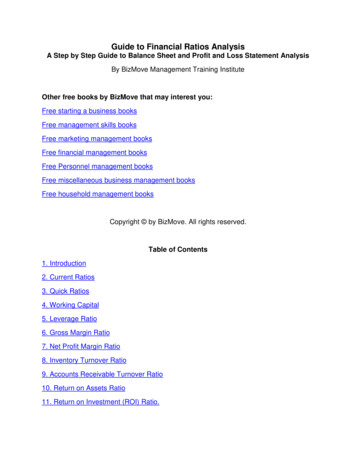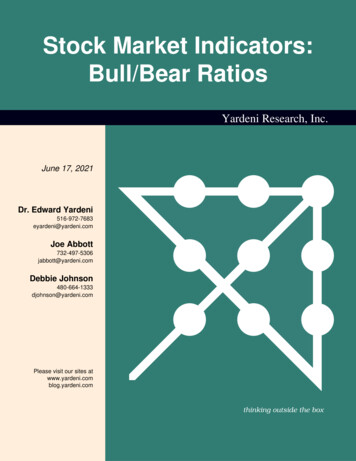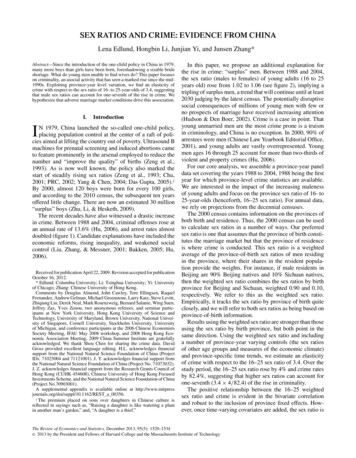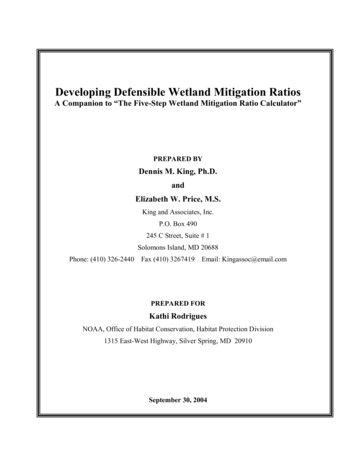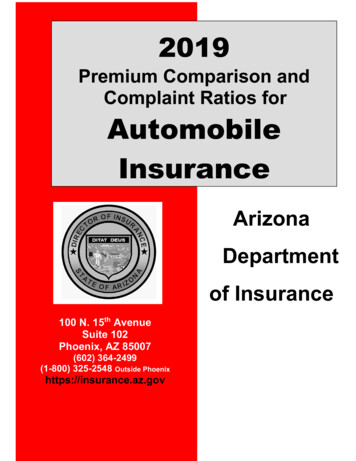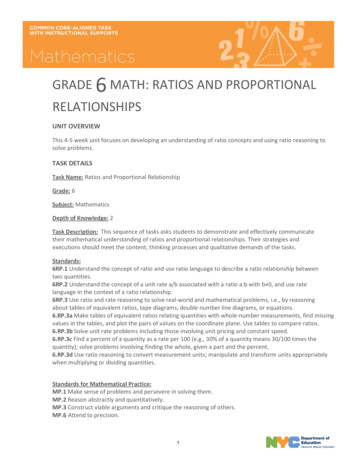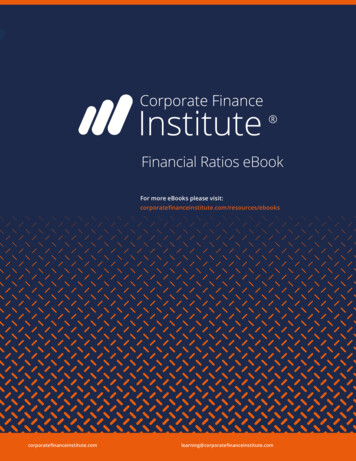
Transcription
The Corporate Finance InstituteThe Analyst TrifectaFinancial Ratios eBookFor more eBooks please inanceinstitute.com1
Corporate Finance InstituteFinancial RatiosTable of ContentsFinancial Ratio Analysis Overview . 3What is Ratio Analysis? .3Why use Ratio Analysis?.3Types of Ratios? .3Profitability Ratio . 4Return on Equity .5Return on Assets .6Return on Capital Employed.7Gross Margin Ratio .8Operating Profit Margin.9Net Profit Margin . 10Leverage Ratios . 11Debt-to-Equity Ratio . 12Equity Ratio. 13Debt Ratio . 14Efficiency Ratios . 15Accounts Receivable Turnover Ratio . 16Accounts Receivable Days. 17Asset Turnover Ratio . 18Inventory Turnover Ratio. 19Inventory Turnover Days . 20Liquidity Ratios. 21Current Ratio. 22Quick Ratio. 23Cash Ratio . 24Defensive Interval Ratio . 25Times Interest Earned Ratio . 26Times Interest Earned (Cash-Basis) Ratio. 27CAPEX to Operating Cash Ratio . 28Operating Cash Flow Ratio. 29Pyramid of Ratios. 30Multiples Valuation Ratios . 31Price-to-Earnings (P/E) Ratio . 32EV/EBITDA Ratio . 33EV/EBIT Ratio . 34EV/Revenue Ratio . 35Valuation Ratios Comparison . 36corporatefinanceinstitute.com2
Corporate Finance InstituteFinancial RatiosFinancial Ratio Analysis OverviewWhat is Ratio Analysis?Corporate finance ratios are quantitative measures that are used to assess businesses. These ratiosare used by financial analysts, equity research analysts, investors, and asset managers to evaluatethe overall financial health of businesses, with the end goal of making better investment decisions.Corporate finance ratios are also heavily used by financial managers and C-suite officers to get abetter understanding of how their businesses are performing.Why use Ratio Analysis?Ratio analysis is a great way to compare two companies that are different in size operations andmanagement style. It also is a great way to quantify how efficient a company’s operations are andhow profitable the business is set up to be. Solvency ratios, for example, can be used to analyzehow well a company will be able to meet their financial obligations.Types of Ratios?Corporate finance ratios can be broken down into four categories that measure different types offinancial metrics for a business: liquidity ratios, operational risk ratios, profitability ratios, andefficiency ratios:corporatefinanceinstitute.com3
Corporate Finance Institute4Financial RatiosProfitability RatioProfitability ratios are financial metrics used by analysts and investors tomeasure and evaluate the ability of a company to generate income (profit)relative to revenue, balance sheet assets, operating costs, and shareholders’equity during a specific period of time. They show how well a companyutilizes its assets to produce profit and value to shareholders.A. Return RatiosReturn ratios represent the company’s ability to generate returns for itsshareholders. It typically compares a return metric versus certainbalance sheet items.Return on EquityReturn on AssetsReturn on Capital EmployedB. Margin RatiosMargin ratios represent the company’s ability to convert sales intoprofits at various degrees of measurement. Margin ratios typically lookat certain returns when compared to the top line (revenue). Typically, itcompares income statement items.Gross Margin RatioOperating Profit MarginNet Profit Margincorporatefinanceinstitute.com4
Corporate Finance InstituteFinancial RatiosReturn on EquityOverviewReturn on equity is a measure of a company’s annual return (net income) divided by the value of itstotal shareholders’ equity, expressed as a percentage (e.g. 10%). Alternatively, ROE can also bederived by dividing the firm’s dividend growth rate by its earnings retention rate (1-dividend payoutratio). There are several ROE drivers, and we will further breakdown the ratio.FormulaInterpretationROE provides a simple metric for evaluating returns. By comparing a company’s ROE to theindustry’s average, it is possible to pinpoint a company’s competitive advantage (or lack ofcompetitive advantage).As it uses net income as the numerator, return on equity (ROE) looks at the firm’s bottom line togauge overall profitability for the firm’s owners and investors.As an investor, this is an essential ratio to look at as it ultimately determines how attractive aninvestment is. Return on equity is a product of asset efficiency, profitability, and financial leverage.corporatefinanceinstitute.com5
Corporate Finance InstituteFinancial RatiosReturn on AssetsOverviewReturn on assets (ROA) is a type of profitability ratio that measures the profitability of a business inrelation to its total assets. This ratio indicates how well a company is performing by comparing theprofit (net income) it’s generating to the total capital it has invested in assets. The higher the return,the more productive and efficient the management is in utilizing economic resources. Below is abreakdown of the ROA formula.FormulaInterpretationThe ROA formula is an important ratio in analyzing a company’s profitability. The ratio is typicallyused when comparing a company’s performance between periods, or when comparing twodifferent companies of similar size and industry. Note that it is very important to consider the scaleof a business and the operations performed when comparing two different firms using ROA.Typically, different industries have different ROAs. Industries that are capital-intensive and requirea high value of fixed assets for operations will generally have a lower ROA, as their large asset basewill increase the denominator of the formula. However, a company with a large asset base can havea large ROA, if their income is high enough, it is all relative.corporatefinanceinstitute.com6
Corporate Finance InstituteFinancial RatiosReturn on Capital EmployedOverviewReturn on Capital Employed (ROCE) is a profitability ratio that measures how efficiently a companyis using its capital to generate profits. The return on capital employed is considered one of thebest profitability ratios and is commonly used by investors to determine whether a company issuitable to invest in.FormulaInterpretationThe return on capital employed shows how much operating income is generated for each dollarinvested in capital. A higher ROCE is always more favorable as it implies that more profits aregenerated per dollar of capital employed.As with any other financial ratios, calculating just the ROCE of a company is not enough. Otherprofitability ratios such as return on assets, return on invested capital, and return on equity shouldbe used in conjunction with ROCE to determine whether a company is truly profitable or not.corporatefinanceinstitute.com7
Corporate Finance InstituteFinancial RatiosGross Margin RatioOverviewThe gross margin ratio, also known as the gross profit margin ratio, is a profitability ratio thatcompares the gross margin of a company to its revenue. It shows how much profit a companymakes after paying off its cost of goods sold (COGS). The ratio indicates the percentage of eachdollar of revenue that the company retains as gross profit, so naturally a high gross margin ratio isdesired.FormulaInterpretationA low gross margin ratio does not necessarily indicate a poorly performing company. It is importantto compare gross margin ratios between companies in the same industry rather than comparingthem across industries.For example, a legal service company reports a high gross margin ratio because it operates in aservice industry with low production costs. In contrast, the ratio will be lower for a carmanufacturing company because of high production costs.corporatefinanceinstitute.com8
Corporate Finance InstituteFinancial RatiosOperating Profit MarginOverviewOperating profit margin is a profitability ratio used to calculate the percentage of profit a companyproduces from its operations, prior to subtracting taxes and interest charges. It is calculated bydividing the operating profit by total revenue and is expressed as a percentage. The margin is alsoknown as the EBIT (Earnings Before Interest and Tax) margin.FormulaInterpretationOperating Profit margin Net EBIT Total revenue x 100The operating profit margin calculation is the percentage of operating profit derived from totalrevenue. For example, a 15% operating profit margin is equal to 0.15 operating profit for every 1of revenue.An example of how this profit metric can be used is the situation of an acquirer consideringa leveraged buyout. When the acquirer is analyzing the target company, they would be looking atthe potential improvements that they can bring into the operations. The operating profit marginprovides an insight into how well the target company performs in comparison to its peers, inparticular, how efficiently a company manages its expenses so as to maximize profitability. Theomission of interest and taxes is helpful because a leveraged buyout would inject a company withcompletely new debt, which would then make historical interest expense irrelevant.corporatefinanceinstitute.com9
Corporate Finance InstituteFinancial RatiosNet Profit MarginOverviewNet profit margin (also known as “profit margin” or “net profit margin ratio”) is a financial ratio usedto calculate the percentage of profit a company produces from its total revenue. It measures theamount of net profit a company obtains per dollar of revenue gained.The net profit margin is equal to net profit (also known as net income) divided by total revenue,expressed as a percentage.FormulaInterpretationNet profit is calculated by deducting all company expenses from its total revenue. The result of theprofit margin calculation is a percentage – for example, a 10% profit margin means for each 1 ofrevenue the company earns 0.10 in net profit. Revenue represents the total sales of the companyin a period.The typical profit margin ratio of each company can be different depending on which industry thecompany is in.corporatefinanceinstitute.com10
Corporate Finance Institute11Financial RatiosLeverage RatiosA leverage ratio is any kind of financial ratio that indicates the level of debtincurred by a business entity against several other accounts in its balancesheet, income statement, or cash flow statement. These ratios provide anindication of how the company’s assets and business operations are financed(using debt or equity).A. Leverage RatiosLeverage ratios represent the extent to which a business is utilizingborrowed money. It also evaluates company solvency and capitalstructure. Having high leverage in a firm’s capital structure can be risky,but it also provides benefits.Debt-to-Equity RatioEquity RatioDebt Ratiocorporatefinanceinstitute.com11
Corporate Finance InstituteFinancial RatiosDebt-to-Equity RatioOverviewThe debt-to-equity ratio is a leverage ratio that calculates the proportion of total debt and liabilitiesversus total shareholders’ equity. The ratio compares whether a company’s capital structure utilizesmore debt or equity financing.The ratio looks at total debt which consists of short-term debt, long-term debt, and other fixedpayment obligations (such as capital leases).FormulaInterpretationIf the total debt of a business is worth 50 million and the total equity is worth 120 million, as perthe above formula, debt-to-equity would be 0.42. In other words, the firm has 42 cents in debt forevery dollar of equity.A higher debt-equity ratio indicates a levered firm – a firm that is financed with debt. Leveragehas benefits such as tax deductions on interest expenses but also the risks associated withthese expenses. Thus, leverage is preferable for companies with stable cash flows, but not forcompanies in decline. The appropriate debt-to-equity ratio varies by industry.corporatefinanceinstitute.com12
Corporate Finance InstituteFinancial RatiosEquity RatioOverviewThe equity ratio is a leverage ratio that calculates the proportion of total shareholders’ equity versustotal assets. The ratio determines the residual claim of shareholders on a business. It determineswhat portion of the business could be claimed by shareholder in a liquidation event.FormulaInterpretationThe accounting equation can be rearranged to Equity Assets – Liabilities. By using this as thenumerator of the equity ratio, the ratio can be written as (Assets-Liabilities)/Assets. In other words,it would be the percentage of total assets after all liabilities have been subtracted.For example, if Company XYZ has a total of 15 million in total shareholder’s equity, and total assetsare equal to 50 million, then the equity ratio of this company would be equal to 0.3. It typically isexpressed as a percentage. Therefore, it would be 30% in the above example.corporatefinanceinstitute.com13
Corporate Finance InstituteFinancial RatiosDebt RatioOverviewThe debt ratio, also known as the debt-to-asset ratio, is a leverage ratio that indicates thepercentage of assets that are being financed with debt. The higher the ratio, the greater the degreeof leverage and financial risk.The debt ratio is commonly used by creditors to determine the amount of debt in a company, theability to repay its debt, and whether additional loans will be extended to the company. On theother hand, investors use the ratio to make sure the company is solvent, have the ability to meetcurrent and future obligations, and can generate a return on their investment.FormulaInterpretationThe debt ratio is commonly used by analysts, investors, and creditors to determine the overall riskof a company. Companies with a higher ratio are more leveraged and hence, riskier to invest in andprovide loans to. If the ratio steadily increases, it could indicate a default at some point in the future. A ratio equal to one ( 1) means that the company owns the same amount of liabilities asits assets. It indicates that the company is highly leveraged. A ratio greater than one ( 1) means the company owns more liabilities than it does assets.It indicates that the company is extremely leveraged and highly risky to invest in or lend to.corporatefinanceinstitute.com14
Corporate Finance Institute15Financial RatiosEfficiency RatiosEfficiency ratios are used to measure how well a company is utilizing its assetsand resources. These ratios generally examine how many times a businesscan accomplish a metric within a certain period of time, or how long it takesfor a business to fulfill segments of its operations.A. Turnover RatiosTurnover ratios examine how many times a business can finish a cycleof a certain metric within a specific period of time. For example, theinventory turnover ratio shows how many times a business can sell anentire stock of inventory in a period of time. Additionally, turnover ratioscan be manipulated to see how many days within a specific period ittakes for a business to complete a cycle for a specific metric instead.Accounts Receivable Turnover RatioAccounts Receivable DaysAsset Turnover RatioInventory Turnover RatioInventory Turnover Dayscorporatefinanceinstitute.com15
Corporate Finance InstituteFinancial RatiosAccounts Receivable Turnover RatioOverviewThe accounts receivable turnover ratio, sometimes known as the debtor’s turnover ratio, measuresthe number of times over a specific period that a company collects its average accounts receivable.The accounts receivable turnover ratio can also be manipulated to obtain the average number ofdays it takes to collect credit sales from customers, known as accounts receivable days.FormulaInterpretationTo calculate this ratio, the following formulas are also necessary:Net Credit Sales Sales on Credit – Sales Returns – Sales AllowancesAverage Accounts Receivable (Accounts Receivableending Accounts Receivablebeginning)/2For example, at the end of a fiscal year, a company has credit sales of 50,000 and returns of 3,200. At December 31st, the company had accounts receivable of 6,000. At January 1st, accountsreceivable was 3,000. Therefore, its accounts receivable turnover ratio for this fiscal period (365days) would be (50,000 – 3,200) / ((6,000 3,000) / 2) 10.4.Analyzing this, the company collects its accounts receivables about 10.4 times a year. This numbershould be compared to industry averages to see how efficient the company is in collectingpayments versus its competitors.corporatefinanceinstitute.com16
Corporate Finance InstituteFinancial RatiosAccounts Receivable DaysOverviewAccounts receivable days are the number of days on average that it takes a company to collect oncredit sales from its customers. This formula is derived by using the previously mentioned accountsreceivable turnover ratio.FormulaInterpretationTo calculate this ratio, it is necessary to use the accounts receivable turnover ratio:Accounts Receivable Turnover Ratio Net Credit Sales/Average Accounts ReceivableUsing the same example, at the end of a fiscal year, a company has credit sales of 50,000 andreturns of 3,200. At December 31st, the company had accounts receivable of 6,000. At January1st, accounts receivable was 3,000. Therefore, its accounts receivable turnover ratio for this fiscalperiod (365 days) would be (50,000 – 3,200) / ((6,000 3,000) / 2) 10.4. We can use thesenumbers to calculate the accounts receivable days, which would be 365 / 10.4 35.1.Analyzing this, it takes the company 35.1 days on average to collect its accounts receivables. As withthe accounts receivable turnover ratio, this number should be compared to industry averages tosee how efficient the company is in collecting payments versus its competitors.corporatefinanceinstitute.com17
Corporate Finance InstituteFinancial RatiosAsset Turnover RatioOverviewThe asset turnover ratio, also known as the total asset turnover ratio, measures how efficient acompany uses its assets to generate sales. This ratio looks at how many dollars in sales is generatedper dollar of total assets that the company owns.FormulaInterpretationTo calculate this ratio, average total assets is calculated as:Average Total Assets (Total Assetsending Total Assetsbeginning)/2Please note, an analyst can also choose to use period end total assets instead of average totalassets.In this example, a company has net sales of 100,000 for the year. On December 31st, the companyhad total assets of 65,000. On January 1st, the company had total assets of 57,000. The company’sasset turnover ratio would then be 100,000 / ((65,000 57,000) / 2) 1.64. This means that forevery dollar of total assets, the company generates about 1.64 in net sales.Like many other ratios, a single period’s asset turnover ratio is not very useful on its own. However,when compared to the asset turnover ratios of comparable companies in the same industry, it canreveal how well the company is doing relative to competitors. The ideal or average asset turnoverratio depends on the industry of the company.A higher ratio is generally favourable as it indicates efficient use of assets. Conversely, a low ratiomay imply poor utilization of assets, poor collection methods, or poor inventory management.corporatefinanceinstitute.com18
Corporate Finance InstituteFinancial RatiosInventory Turnover RatioOverviewThe inventory turnover ratio measures how many times a business sells and replaces its stock ofgoods in a given period of time. This ratio looks at cost of goods sold relative to average inventoryin the period.This ratio indicates how efficient a business is at clearing its inventories.FormulaInterpretationTo calculate this ratio, average inventory is calculated as:Average Inventory (Inventoryending Inventorybeginning)/2For example, a company has cost of goods sold of 3 million for the fiscal year. On December 31st,the company’s inventory was 350,000. On January 1st, inventory was 260,000. Therefore, thecompany’s inventory turnover ratio would be 3,000,000 / ((35,000 26,000) / 2) 9.84. Thisnumber means that the company sold its entire stock of inventory 9.84 times in the fiscal year.Additionally, like the accounts receivable turnover ratio, the inventory turnover ratio can bemanipulated to give inventory turnover days – the average number of days it takes to sell an entirestock of goods.corporatefinanceinstitute.com19
Corporate Finance InstituteFinancial RatiosInventory Turnover DaysOverviewInventory Turnover Days are the number of days on average it takes to sell a stock of inventory.This formula is derived using the previously mentioned inventory turnover ratio. Like the inventoryturnover ratio, inventory turnover days is a measure of a business’ efficiency.FormulaInterpretationTo calculate this ratio, the inventory turnover ratio is necessary:Inventory Turnover Ratio Cost of Goods Sold/Average InventoryUsing the same example, a company has cost of goods sold of 3 million for the fiscal year. OnDecember 31st, the company’s inventory was 350,000. On January 1st, inventory was 260,000.Therefore, the company’s inventory turnover ratio would be 3,000,000 / ((35,000 26,000) / 2) 9.84. This number means that the company sold its entire stock of inventory 9.84 times in the fiscalyear. We can use these numbers to calculate the inventory turnover days, which would be 365 /9.84 37.1.Analyzing this, it takes the company 37.1 days on average to sell an entire stock of inventory. Aswith the inventory turnover ratio, this number should be compared to industry averages to see howefficient the company is in converting inventory into sales versus its competitors.corporatefinanceinstitute.com20
Corporate Finance Institute21Financial RatiosLiquidity RatiosLiquidity ratios are used by financial analysts to evaluate the financialsoundness of a company. These ratios measure a company’s ability to repayboth short-term and long-term debt obligations. Liquidity ratios are oftenused to determine the riskiness of a firm to decide whether to extend creditto the firm.A. Asset RatiosAsset ratios look at a company’s balance sheet assets to evaluateliquidity. These ratios generally use increasingly stricter variants ofcurrent assets to determine a company’s level of solvency.Current RatioQuick RatioCash RatioDefensive Interval RatioB. Earnings RatiosEarnings ratios use a company’s earnings to evaluate liquidity. Theseratios may use different variants of earnings (e.g. EBIT, EBITDA)depending on the needs of the financial analyst.Times Interest Earned RatioC. Cash Flow RatiosCash flow ratios utilize a company’s cash flows to determine liquidity. Byusing cash flows, financial analysts can determine how well a company’sday-to-day operations cover debt obligations.Times Interest Earned (Cash Basis) RatioCAPEX to Operating Cash RatioOperating Cash Flow Ratiocorporatefinanceinstitute.com21
Corporate Finance InstituteFinancial RatiosCurrent RatioOverviewThe current ratio, otherwise known as the working capital ratio, measures the ability of a businessto meet its short-term obligations that are due within a year. The ratio compares total currentassets to total current liabilities. The current ratio looks at how a company can maximize theliquidity of its current assets to settle
Ratio analysis is a great way to compare two companies that are different in size operations and management style. It also is a great way to quantify how efficient a company’s operations are and how profitable the business is set up to
